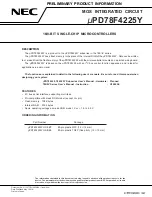
Chapter 11. 3DM 2 Reference
206
3ware Serial ATA RAID Controller User Guide
Unit Information
Unit Number.
The unit number assigned to the unit by the firmware. Use the
checkbox next to the unit to select a unit before clicking one of the task
buttons.
# Drives.
Number of drives in the unit.
Type of Unit.
Type of unit: RAID 0, RAID 1, RAID 5, RAID 6, RAID 10,
RAID 50, Single Disk, JBOD, or Spare. If the unit has been given a unique
name, it shows beneath the RAID type.
Name of Unit.
User-assigned unique name of the unit. The default setting is
blank.
Capacity.
The usable capacity (size) of the unit.
Status.
Operational status of the unit: Ok, Rebuilding, Initializing, Verifying,
Migrating, Degraded, or Inoperable (missing drives). When Rebuilding,
Initializing, Migrating, or Verifying, the percentage (%) complete is also
shown. The percentage complete can be active or paused. To see whether this
task is currently active or paused, click on the unit number to display the Unit
Details page, which has that information. For an explanation of the statuses,
see “Unit Statuses” on page 140.
Drive Information
Port.
The port to which the drive is connected.
Model.
The model of the drive.
Capacity.
The capacity (size) of the drive.
Status
. The status of the drive: OK, Not Supported, Not Present, and so forth.
If you need help regarding a status displayed here, please contact Technical
Support.
For more information, see “Drive Statuses” on page 142.
Remove Drive.
The
Remove Drive
link removes a drive from the controller
so that you can safely unplug it. In the Unit Maintenance section, this link is
only provided for drives that can be safely removed without creating an
inoperable unit. (For example, a RAID 5 missing 2 or more drives or a RAID
0 missing 1 or more drives would become inoperable.) If you remove a drive
from a redundant unit, the unit will become degraded. Once a unit has become
degraded, additional drives cannot be removed without making it inoperable,
so no
Remove Drive
link will display.
















































